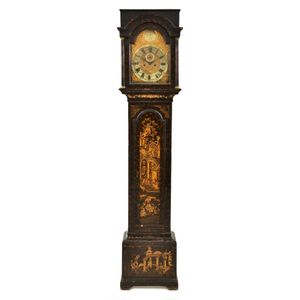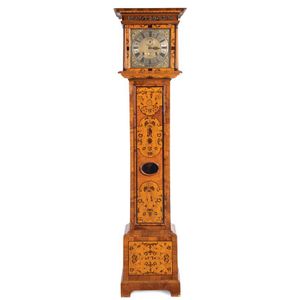Marquetry Long Case Clock by Samuel Bryan Jnr
You must be a subscriber, and be logged in to view price and dealer details.
Subscribe Now to view actual auction price for this item
When you subscribe, you have the option of setting the currency in which to display prices to $Au, $US, $NZ or Stg.
- Calendar Aperture - A calendar aperture on a clock refers to a small window on the clock face that displays the day, month or year or all of these. The aperture is usually located on the clock's dial with the date data recorded on a wheel which is designed to rotate to show the correct date information.Some clocks have a manual adjustment for the date, while others are designed to automatically adjust for the date, including for leap years. The calendar aperture is a useful feature found on clocks from the 16th century, and on many types of clocks, including wall clocks, alarm clocks and wristwatches.
- Hood - In longcase clocks, the hood is the wooden case that surrounds the works and dial, and includes the glass front, which is usually hinged, so the door can be opened to wind the clock or adjust the time. In 18th and 19th century longcase clocks the hood usually slides forward for removal, allowing access to the works.
- Date Aperture - A date aperture is a cut out section in the face of a watch or clock, displaying the day of the month.
- Lenticle in a Long Case Clock - A lenticle in a long case clock (also known as grandfather clocks) is a convex lens used usually located as a small circular window on the front door of the clock case, just below the clock face. The lenticle enables the pendulum to be viewed without needing to open the door in the trunk. The lens is convex, meaning that it bulges outward, and is made of glass
- The Eagle - The eagle has been a symbol of power, victory, and strength for centuries. It is often associated with bravery, prowess, and dominance, and has been used as a symbol by many cultures and civilizations throughout history.
In ancient Greece, the eagle was associated with the god Zeus, who was considered the king of the gods and the ruler of the skies. In many cultures, the eagle was seen as a messenger between the physical world and the spirit world, and was associated with the sun and the sky.
In the Roman Empire, the eagle was the symbol of the Roman army, and was displayed on the standards of the soldiers to show the power and authority of the empire. In medieval Europe, the eagle was used as a symbol of power and victory by monarchs and rulers, and was often depicted in art and architecture as a symbol of strength and courage.
In modern times, the eagle continues to be a symbol of power, victory, and strength. It is often used as a symbol by nations and organisations, and is frequently depicted in art and on monuments to commemorate important events and achievements.
The eagle's powerful appearance, combined with its association with freedom, courage, and dominance, makes it a popular and enduring symbol of power and victory. - Finial - An architectural decoration, found on the upper parts of of an object. On furniture they are usually found on pediments, canopies and shelf supports. On smaller ceramic or silver items, such as spoons, they may decorate the top of the item itself, or the lid or cover where they provide a useful handle for removal.
Finials have a variety of shapes and forms. They may be urn-shaped, baluster shaped round or spiral, but usually taper into an upper point. Many real life shapes may also be used as finials, such as pineapples, berries, pinecones, buds, lotus and acorns. Sometimes animals such as a lion are depicted, or fish and dolphins. - Chapter Ring - A separate metal plate on the face of a clock, on which the numerals for the hours and sometimes parts of the hours, are displayed, usually wheel shaped and sitting on top of the dial plate. The chapter ring is often a feature of the clock and can be silvered or enamelled to stand as a contrast to its background. The hours are usually shown in Roman numerals, although in the late 19th and earlt 20th century, Arabic numerals became fashionable.
This item has been included into following indexes:
Visually similar items

A Chinoiserie long case clock, John Anderson Wigton, the gilded black lacquered case decorated with a Chinese court scene on a simulated tortoise shell ground, the shaped glazed door enclosing an engraved and silvered dial with Romana and Arabic numerals o

A rare square dial marquetry cased longcase clock, English, early 18th century signed Jos. Hechstetter, London Note: Sg.H. Baillie's Watchmakers and Clockmakers of the world, first published by Methuen, London in 1929, records Joseph Hechstetter as flouris

A George III red lacquered chinoisere cased clock, English, 18th century, signed Jon. Draper, London, 244 cm high, 40 cm wide, 24 cm deep

A George III mahogany longcase clock, the dial signed William Lee, Leicester the brass Roman numeral dial with subsidiary seconds dial and calendar, housing an anchor escapement on one bell, 223.5 cm high
